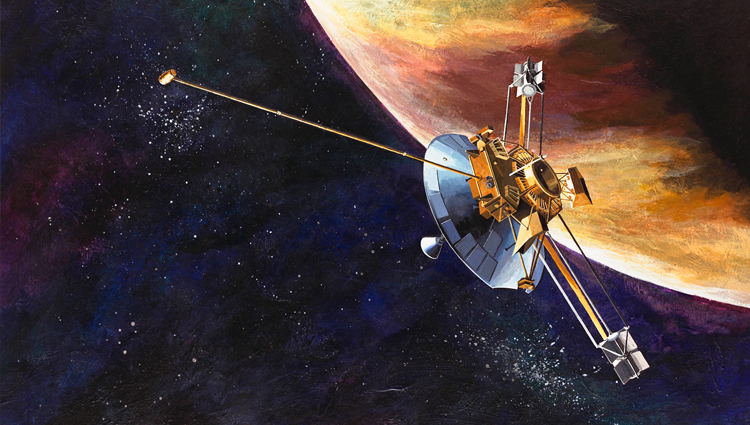Mystery Force May Be Due To Mirrors
40-year old NASA space probes are still heating up the field of astronomy after identifying mysterious 'anomaly'.
Image

Media credits
(ISNS) -- Portuguese physicists report that they have identified the unknown force whose influence on outward bound interplanetary space probes has puzzled scientists since 1998.
Until now, theorists speculated that this "Pioneer anomaly," -- affecting NASA's Pioneer 10 and 11 -- is caused by unseen matter in space, the gravity of an unknown planet, or even new principles of physics: beyond even Einstein's theory of general relativity.
This anomaly is one of a long line of mysterious motions in our solar system, many of which were resolved when investigators discovered new objects or physical effects.
Case in point: In the 19th century, Uranus deviated from its calculated orbit and the gravity of an unknown planet was suggested as the cause. In 1846, the discovery of Neptune solved the mystery. Astronomers blamed a quirk in Mercury's orbit on the influence of undiscovered matter near the sun, perhaps in the form of a small planet, or on a problem with Newton’s theory of gravity. The third suggestion panned out in 1915 -- Albert Einstein's general theory of relativity -- an advance beyond Newton, explained the Mercury effect.
Johann Encke, a 19th century German astronomer, found that a comet returned 2.5 hours early on each 3.5 year orbital trip. Encke suspected that the comet -- now named after him -- was plowing through a thin, resisting medium that was pulling it slowly toward the sun, making the orbit slightly smaller and the round-trip faster. However, some comets arrive later than expected, not early. The once mysterious force that causes the comets to belie their timetables was identified in 1950 by American astronomer Fred Whipple: gases streaming from a comet act like rocket propulsion, advancing or decreasing the comet's motion, depending on stream direction.
In the 1980s, the Naval Observatory searched telescopically for a hypothetical Planet X, to explain possible discrepancies in the orbit of Uranus, finding nothing. But an astronomer at NASA's Jet Propulsion Laboratory, John D. Anderson, hunted X in another way: he searched for deviations in the trajectories of Pioneer 10 and 11 that could be due to the gravity of the supposed planet.
The Pioneer satellites were launched in 1972 and 1973, respectively. By March of 1997, Pioneer 10 was already far beyond Pluto, a little more than 6 billion miles away from the sun. Anderson’s Planet X hunt failed, but in 1998 he and coworkers announced the discovery of the Pioneer anomaly: the probes were moving outward less rapidly than planned. By 2007, the Pioneers were about 250,000 miles short of their predicted distances from the sun, according to "The Hunt for Planet X" by Dutch writer Govert Schilling.
The Portuguese physicists -- including Orfeu Bertolami and graduate student Frederico Francisco of the Instituto Superior Technico in Lisbon -- said that the mystery force originated in the Pioneer spacecraft themselves.
Bertolami's team calculate that infrared radiation from warm parts of each spacecraft, notably the radioactive thermal generators that powered them, and the main equipment compartment, where electrical power from the generators was used to operate electronics, bounces back and forth between exposed surfaces and exerts pressure on the back of each spacecraft's 9 foot wide onboard parabolic radio antenna pointing toward Earth. Seen from a great distance, the Earth is very close to the sun in the sky, and so pressure on the antenna represents a force on the spacecraft in the direction of the sun.
The possibility that onboard heat causes the Pioneer anomaly was considered and dismissed by Anderson in 1998. Jonathan Katz, a physics professor at Washington University in St. Louis, Mo., disagreed, suggesting in 1999 that indeed heat is the culprit. The Portuguese physicists used detailed computer modeling to produce the most precise simulation of Pioneer heat flow yet, including both mirror-like and diffuse reflection from spacecraft surfaces. In their paper, they conclude that heat does the trick and "unless new data arises, the puzzle of the anomalous acceleration of the Pioneer probes can finally be put to rest."
Katz said that if he were the referee on the Portuguese paper, "I'd recommend publication."
Alan Stern, a former head of space science at NASA and the Principal Investigator of the New Horizons spacecraft that’s now en route to Pluto, said that "I don't think there is any longer any credible evidence" that the Pioneer anomaly originates from anything but heat.
The Pioneer effect will likely be just a footnote in the history of space exploration, but for now, at least it's the end of one mysterious anomaly.
RELATED: Pioneer Mission Page - NASA
ISNS contributing writer Stephen P. Maran is the author of Astronomy for Dummies.
